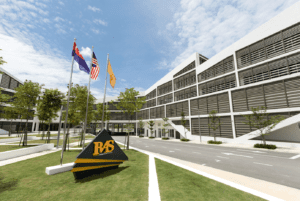Class Size and Curriculum
Class Size
To maintain the quality of our educational program, class sizes are limited to the following.
| Grade Level |
Maximum number of students |
| Early Childhood (PreK and Kinder) |
18 students |
| Elementary (Grades 1-5) |
22 students |
Elementary Curriculum
The fundamental belief of American education is the concept of educating the whole child for the successful realization of dreams and goals. Our curriculum is based on what we truly believe all students should know and be able to do, now and in the future. We support and challenge students to embed learning outcomes, such as communication skills, organizational and research skills, and problem-solving/thinking skills into our curriculum for all ages. We provide students with engaging learning opportunities to grow in compassion, responsibility, integrity, and respect. Our faculty use formative and summative assessment strategies to enable students to demonstrate these attributes in meaningful ways so that all students have opportunities to think, create and succeed.
Curriculum Overview
Language Arts: Reading, Writing, Listening and Speaking, is instructed through a balanced literacy approach. Reading, writing, listening, speaking, phonics, spelling, and word study are studied in an integrated style through the use of a variety of quality literature. Students work with leveled texts and learn to decode, develop comprehension strategies, and improve their independent reading level at an increasing degree of complexity. Students also focus on nonfiction texts as they acquire the skills to interpret information, research, and question material presented. Writing is focused on engaging students in meaningful context for the purpose of communicating their ideas. Students are guided through modeling, reflecting on model examples, sharing their own work, and peer editing the work of others. A consistent framework is used for writing to demonstrate what strong writing looks like through focus on ideas, organization, voice, word choice, sentence fluency, conventions and presentation. Students are encouraged to publish their written work in various formats for the genre produced.
Mathematics: Students study Mathematics through a focus on the Common Core Eight Mathematical Practices. The practices of ‘make sense of problems and persevere in solving them,’ as well as ‘attend to precision,’ are consistently emphasized as applicable to all areas of mathematical study. Students engage in critical thinking as they ‘reason abstractly and quantitatively’ and ‘construct viable arguments and critique the reasoning of others.’ Problem-solving involves the ‘use of appropriate tools strategically’ and ‘model with mathematics.’ Strategic thinking also requires that students ‘look for and make use of structure,’ while ‘expressing regularity in repeated reasoning.’ These Eight Mathematical Practices, along with the development of the four general learning outcomes, form the backbone for the mathematics curriculum. Students learn through direct instruction, fluency practice, games, math investigations, and collaboration. Study in mathematics requires student-generated problems, working with manipulatives, group investigations, and classroom discussion. The Common Core Curriculum emphasizes a firm foundation and fluency in addition and subtraction before formalizing the algorithms for multiplication and division. Rational number study follows multiplication and division fluency as students are prepared for higher-level math classes. Measurement, Data, Geometry, Algebraic Thinking, Statistics, and Probability are integrated into each grade level with various emphasis.
Science: The study of science at RAS is focused on the use of the scientific method. From the early grades, students are encouraged to wonder and question the world around them. Students learn Biology, Chemistry, and Physics each year as they investigate the many happenings within the world in which we live. Directed reading of factual, informational text provides the basis for vocabulary and concept acquisition. Teachers engage students in experiments while emphasizing research, observation skills, safety, recording tools, and communication of conclusions. Students are encouraged to interact with their environment, pose additional inquiries, research, and share their thoughts collaboratively.
Social Studies: The Social Studies program begins with the microcosm of self and family, and it gradually expands to today’s global issues. As a student progresses from self and family to community, state, country, region, and the world, they acquire the skills necessary for mapping, interviewing, filmmaking, and documentation. Students deepen their understanding of government, conflict, change, technology, and culture in the Asian region, ultimately leading to the study of the global order and issues of today.
World Languages: The World Languages currently offered at RAS include Bahasa Malay and Mandarin. Mandarin is offered in two classes; one for native speakers and one focusing on Language Acquisition. Communities, Connections, Cultures, Comparisons, and Communication are the focus of the language units.. Students will continue to advance their knowledge in reading, writing, listening, and speaking in their target language.
The Arts: Students participate in both Visual Arts and Music classes as part of our Elementary program. Learning experiences in Visual Arts and Music gives students opportunities to learn about the creative process whilst developing skills and techniques. Through The Arts, students are able to inquire into other cultures and history and are encouraged to make connections between their personal experiences and the world around them. Visual Art and Music are valued as opportunities for students to develop their creativity and self-expression. Dance is incorporated into our Physical Education Program. Students in Pre-School also participate in Music and Movement classes each week.
Physical Education: Health, Fitness, and Wellness are the focus of the Physical Education program. Physical activity is critical to the development and maintenance of good health. The goal of this program is to develop educated individuals who have the knowledge, skills, and confidence to enjoy a lifetime of healthful activities. Students demonstrate competency in motor skills and movement patterns needed to perform a variety of physical activities. Students develop an understanding of movement concepts, principles, strategies, and tactics as they apply to the learning and performance of physical activities. RAS emphasizes participation in physical activities, development of social and personal respect for others in physically active situations, and a lifelong enjoyment of activity-based challenges and expression.






